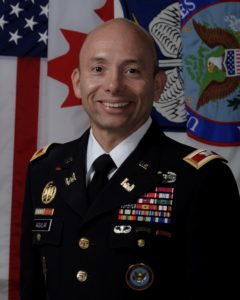From Young Immigrant to West Point Graduate to Career Combat Engineer: Colonel (ret.) Jose L. Aguilar, United States Army
Born in Mexico, young Jose Aguilar went to live with his aunt in Dickinson, Texas from age 9 on, and attended Catholic, then public schools, there. Upon graduation from high school, Aguilar had some important decisions to make. For starters: What’s next? He had gone through the Air Force JROTC program at his high school, so perhaps continue on with that track to become an Air Force officer. But then a friend, one grade ahead, started talking about West Point. These two possibilities now centered within his mind, as he began thinking more seriously about colleges. Aguilar was a long-time participant in martial arts, and some of his older friends and mentors from that tight-knit group, began advising him on various higher education possibilities and, especially, as they were quick to remind, the costs of attending!
Contemplating all that he had absorbed on his own, and from conversations with friends, about which post-high school direction to take, Aguilar finally boiled it down to five key choices. His first & second would be attending a military academy, either Air Force or Army. His third option was to attend in-state Texas A&M. Fourth, would be to attend, also in-state, the University of Houston. The fifth and last on his “what if” list was a non-university back-up possibility, something completely different: attending the state’s police academy near Austin. He had a good friend in his martial arts group who was also an experienced police officer. So, he had gone to visit him, on the job, “to see what the possibilities were,” remembered Aguilar.
Following that law enforcement exposure, his thoughts began turning back to an academic path. He realized, early on, that if he went to Texas A&M or Houston, he would have to work to handle the costs, whereas attending one of the academies, were he to be accepted, would be cost-free. Despite his high school years in Air Force JROTC, after considerable thought, he decided that attending West Point would definitely be his first choice. Now, all he had to do, was get in! A process, as he quickly discovered, that was considerably more involved than that of more regular university admission.
As he recalled: “It involved, first and huge, a Congressional nomination, along then with mental, physical, and dental evaluations, and the normal teacher (and/or employer) written recommendations, all were a part of the overall application process.” His high school academics were strong (approximately 3.5/4.0), quite impressive enough, especially when remembering that he had to learn English when he moved here from Mexico! Meaning that he had started out in Texas schools one grade level behind, to help compensate for his language deficit. Additionally, with academics, he had progressed so well, that by high school, he was taking honors classes in the subjects that we today identify as STEM, “in order to get the best education possible.”
Initiating the application requirements, he scheduled his mental and physical testing, which he successfully passed. Aguilar then outlined the three remaining requirements (“challenges”) he faced, in order to successfully complete the full West Point application process. The first challenge, of course, was obtaining that required Congressional nomination, a task initially hampered by not knowing anyone, at that time, in federal political office. Later, while talking with friends, he learned that then-Texas Congressman Jack Brooks was due to speak soon at Galveston’s County Park (Walter Hall Park). Aguilar decided that his goal would be to attend that speech and, when finished, approach the Congressman to request an Academy nomination. All went as planned. Congressman Brooks was very accommodating, “linking me up with one of his aides, a really nice young lady, who then walked me through the whole process, so that my paperwork would be complete,” said Aguilar. That impactful encounter started the West Point Express rolling.
His second major personal challenge had to do with dental. Unbeknownst to him at the time, he discovered that he had some serious issues, all resulting from a chipped tooth, which had likely occurred many years before, during a playground fight. That chipped tooth had never been an issue, nor had it been closely looked at prior, resulting, now, in an infection found to be running through the tooth, down into the root canal area, and on down into the chin bone! This would result in the need for dental surgery, costly stuff, and a tough prospect for this potential West Point selectee, whose financial resources at that point were, needless to say, quite limited (understatement!). Where to get ideas and direction? It would be his long-time martial arts teacher who provided him with the needed ‘pull’.
In fact, his karate instructor, whom he’d been with since age 13, had a couple of adult students who were dentists (what are the chances?). So, his instructor arranged for Aguilar to see one of them for his initial examination. That karate-student dentist took a look and said: “I can take care of just about everything, but the surgical part needs to be done by a specialist. I’ve got a friend and I’ll ask him to see you.” And, with that, the incredibly fortunate karate connections just kept going! Thanks to this understanding karate-connected dentist, the only thing he charged fellow-student Aguilar, both for his initial exam and procedural work, was the time spent by his dental assistant! All of this dentist’s professional skill and effort to correct what he could of Aguilar’s teeth was done at no charge. And his generous assistance for this impressive young man didn’t stop there. He then referred Aguilar to a close friend and colleague, a surgical dentist, who took care of all that extensive deep infection issue, and, while not doing so completely free, as Aguilar recalls, his charge was very minimal, due no doubt as a favor to his dental colleague. And, also, quite probably because he knew that this bright young man, a legal immigrant, was working very hard to gain admission to West Point, in order to become a stand-out officer in the United States Army.
So, that meant one challenge now completed (dental), one pending (Congressional appointment), and the last, a very big one indeed: Citizenship. Although here in America from an early age, at that time, he had neither obtained, nor apparently needed formal U.S. citizenship. But, now, there’s no way, of course, that he’d be entering West Point without it.
So, it was off to the nearest INS office (Immigration & Naturalization Service, back then). The folks there were, again, quite helpful, outlining what he needed to do for his citizenship test, and to that end, gave him the necessary study guide. Although he was not quite yet 18-years-of-age, those good folks decided to move ahead and allow him to take the required U.S. citizenship test, but they would not be releasing his score until his actual 18th birthday. He took the test. And on his actual birth date, he returned to INS, got his test score, and learned that he had passed. Next step: the scheduling of his official swearing in. Big problem. “Turned out, the schedule for my swearing-in was a one-year wait!” recalled Aguilar. Upon hearing that, as thoughts (and disappointment) raced through his mind, the realization hit him that he would have to do a year at a community college first, since there was now no way that he could complete his citizenship in time for that year’s West Point enrollment.
And then, once again, fate intervened on his behalf. Seems there was a West Point recruiter in town (Colonel Jackson, as he remembers) working to convince top-prospect local high school seniors to consider the Academy. The West Point admissions office must have asked him to follow-up with applicant Aguilar, since virtually all his requirements but two had been met, but they’d heard nothing further from him. So, as Aguilar recalls, the Colonel called him on a Thursday. He brought the recruiter up to date on all that he had completed, but that in order to fully complete his citizenship requirement, the actual swearing-in, he was now facing a one-year wait! Shortly thereafter, they concluded their call.
Later that same day, the Colonel called back. “I have no idea what he did,” said Aguilar, “but that Saturday, just two days later, I found myself standing on a huge football field in Houston for my swearing-in ceremony!” Thank you, Colonel Jackson!
As soon as that was all official, he sent the citizenship certification to West Point. Then he contacted Texas Congressman Brooks’ office and sent the citizenship notice to him, as well. It wasn’t but a week or two later that Aguilar received word back from the Congressman that he was to be one of his nominated candidates! A short time later, Aguilar then finally received word from West Point that he had been approved, “if he chose to accept the appointment,” which of course he did, with zero hesitation! “So, at that point, I’m, now in!” recalled a greatly-relieved “Cadet Candidate” Aguilar. It must be noted, here, that he had worked toward this acceptance goal all during his high school junior and senior years. This whole process wasn’t days or weeks. It was a comprehensive, non-stop, many months-long effort.
And that’s an important key to emphasize. Recalling that this whole, lengthy, winding application road began with an initial encounter with that Texas Congressman following his speech in a near-by community park. That whole process clearly demonstrated personal initiative on Aguilar’s part, followed by the continued persistence needed to make it through all those goal-directed hoops. Did he have important help, and right-time/right-place good fortune along the way? Yes, indeed he did. But much of that would not have happened, had he not continually demonstrated that he was both worthy of, and quite serious about, West Point admission. With his solid academic achievement and his demonstrated personal character in tow, he was determined to get there, blessed with, and driven by, the initiative, discipline, dedication, persistence, and the follow-through needed to make his academic (and career) goal happen. Those are fundamentally important qualities that can determine initial & future career opportunities and achievement, whether in the military or in the civilian work force.
Moving forward, what then, looking back, turned out to be his most vivid memories of those mentally and physically demanding West Point years (1987-1991)? Following his arrival on campus, due to the rigorous First Year requirements, restrictions and expectations, he remembers “kids were dropping out left and right.” Recalling Aguilar’s own demanding path to West Point acceptance, there was no question that he was there to stay. Said he: “Unless they carry me out of here on a stretcher, I’m not leaving this place! I had made a commitment, yes, to the nation, but also to my family. I was not going to go back to my home and tell my Dad that I had quit.” By comparison, he did recall that more than a few of his beginning classmates had apparently relied on their parents to assist with, or handle outright, the complex application process. “Turns out, those students had no skin in the game, so that when it all became difficult and demanding, and, no question, it was (!), they just decided to leave.”
Other key memories: “There is no other place, that I’ve ever been a part of, that gives you everything you need to excel, both physically, mentally, and spiritually, everything. There are great people you’re surrounded by. You’re given time for worship (very important to him). The library there contains everything you’d ever need academically. The instructors are great. And as instructors at West Point, through the ages have said, most of the history they teach there was made by people they taught! Also, you have the best physical training facilities, and you’re afforded the opportunity to use them for your own betterment. There is just no better place for all-around self-improvement that I know of than West Point. And, you don’t have to worry about funding. Everything’s given to you,” said Aguilar.
However, he did say, speaking to what some people may see as a negative; “There is NO free time for anything else. Your time is filled. You are improving yourself, whether you want to or not! Oh, and talk about a meritocracy. Back in high school, you were constantly being judged by the clothes you wore, the things you did, your family’s reputation, etc. But at the Academy, you quickly learn that everyone’s on the same page. Same background. You are judged on what you do, or don’t do, there. Honestly, to me, that was a pretty darn good environment. They continually challenged you,” remembered Aguilar.
As for his academic preparation back at Dickinson High School, he felt that he was well prepared in the math and science areas, where he had taken honors classes and had excelled. But the Academy stressed well-rounded achievement in every aspect of Army officer preparation. So, when it came to subjects like history, English, and other social science/humanities courses at West Point, Aguilar felt that “to say I was in the bottom half, was a compliment to me! I had to work very hard in those subjects.”
It was at about that time when computers were being introduced, both there and throughout American government, businesses, and society in general. He recalled that “ours was the first class to be computer-based, on day one. And here’s what really helped me with that. Back in grade school, a friend convinced me to take typing. Besides trying to find the power button on that thing (computer), if I hadn’t taken typing, that would’ve been really tough, since, from then on, everything was required to be submitted on the computer, as they were then making that complete transition. And all of that was difficult for me,” said Aguilar. For 1987 computer perspective: Microsoft released ‘Word-3’ and introduced ‘Microsoft Works’ that year. Also: The Mac SE was introduced and priced at $2,900 (in 1987 dollars!). And that same year, IBM released its first laptop, featuring dual 3.5” floppy-disk storage. It weighed 13-pounds (good for added strength conditioning!).
When asked whether he considered himself to have been well prepared, overall, when he showed up at West Point, his response was an emphatic: “NO! It was very difficult. Not only looking at the academics, but the rigor of the entire program. Academics was only one part of it. The rest of it was memorizing things; having to work hard from very early morning to very late at night, and still continuing to study. Your every moment had a purpose. And that purpose is to better develop yourself. Even when you take a little bit of down-time to maintain your sanity, it has a purpose, and that purpose, no surprise, is being able to maintain your sanity, so that you can continue to do the things you need to do,” recalled Aguilar.
At the Academy, every cadet must be involved in some form of athletics, either a school team or intramurals. Aguilar’s sport was martial arts. He entered West Point as a Black Belt in karate, and so he joined that team (and became its co-captain during his senior year). He and his fellow karate cadets competed against Ivy League schools, the Air Force Academy, and others. “When I spoke about maintaining sanity,” said Aguilar, “karate was one of the things I excelled at. Like other things in life, I had dedicated the necessary time, energy, and effort, over many years, to be good at it. And it was something that I really, really enjoyed. So I think that activity (karate), coupled with going to Mass every Sunday, were the things right from the beginning, before developing relationships with classmates, that really gave me the foundation and the motivation to continue, as demanding as it was, at West Point.”
As he prepared for graduation and commissioning (1991), along with final exams, Aguilar needed to submit his branch requests. His list of preferences came down to three: Aviation, Infantry, and Engineers, in that order. After pondering (just a fancy, almost-second-lieutenant, word for thinking about), he decided against aviation because, after four tough years at the Academy, yet another year of schooling just didn’t appeal to him. Rather, he really just wanted to start contributing right away. So, then: (1) Infantry and (2) Engineers, became his adjusted preferences. That is until one night, very close to the submission cut-off, while studying for an engineering exam, he began to think about all of the coursework time he’d spent in that major. Then and there, he concluded that it would be foolish not to pursue the Engineer branch as his first choice. He rationalized his decision by recalling that Army engineers spend a lot of time in the field, like the infantry, so engineering might well be the best of both worlds. “So, at the last minute, I withdrew Infantry, and selected Engineers as my first preference…and I got it!”
After branch, came selection of location. To which post or unit did he hope to be assigned? “Frankly, there wasn’t much left on the board when I got a chance to pick,” recalled Aguilar. “So, I ended up picking Fort Sill, Oklahoma. Partly because I didn’t want to go to Korea, which did not appeal to me. And there were a couple of other places I wasn’t excited about. But Fort Sill was close to Texas, so on weekends, I could go visit family. And quite honestly, thinking back to those days and decisions, my goal was to do my five-year commitment, followed by and three-years of ready reserve, and then I’m out. At the time (1991), that was my thought,” he remembered. But how times would change for this Second Lieutenant, and all for the good.
Before heading to Fort Sill (which ended up being Fort Carson instead, because his assigned engineer unit was then scheduled to move to the latter), Aguilar was, instead, off to the Engineer Officer Basic Course at Fort Leonard Wood (MO). Of interest to Aguilar there, far more than the instruction, was meeting fellow engineer student, 2LT Suzanne Calahong, who would become his wife. Even more interesting and serendipitous, they had both graduated from West Point, in the same Class Year, but had never actually met while at the Academy! But, first things first. Following the Leonard Wood course, Aguilar was off to Ranger School at Fort Benning (GA), in January 1992, just six-months after West Point graduation.
Army Ranger Training: A key memory he had from the rigors of that Special Operations instruction sequence was that it teaches you about your limits. “And then after you understand what you think your limits are, it teaches you that you can actually go further,” recalled Aguilar. But through it all, the hard, long, cold, sleep & food deprived, physical and mental challenges, he concluded: “It also teaches you something else that I will always use. And that is, when you are part of a team, whether you’re the leader or led, you need to give it your all, to accomplish the mission. And that’s because, pretty soon, people figure out whether you just shine when you’re put in a leadership position (termed ‘Spotlight Ranger’), or whether you’re a team player all the way through.” This lesson has direct military career applications and relevance regardless of branch or specialty. “Within the Army, you go from a leadership position to a staff position, and you need to perform well in all of those assignments. Not just coast, because you’re in a staff position, and wait until you’re a leader to really work hard. Because, normally, if you’re working hard in a staff position, that’s making a leadership position easier for someone else. So, that’s a huge lesson that I learned,” he said.
There are several training phases for future Rangers (three now, but four when Aguilar was going through). The first, at Fort Benning, focused on squad level basics and missions. Phase two was mountain and focused on platoon level operations. Three was desert. And Four was the “swamp” phase in Florida. Fresh back from leadership in Gulf War I, General Barry McCaffrey was his class graduation speaker, marking the conclusion of Aguilar’s Ranger experience, which finished up back at Fort Benning. Sixty-seven days of hard, humbling training later, Aguilar proudly wore his new Ranger Tab, as he headed now, finally, to Fort Carson (CO).
There he joined the 299th Engineer Battalion as a Sapper Platoon Leader. Or almost. His unit had not quite yet arrived from Fort Sill, so he and two others worked to make preparations for that anticipated relocation. The delay also gave him time to become thoroughly familiar with Carson’s facilities and its ranges. “I knew down-range Fort Carson probably better than those young soldiers who had been there for three or four years, because I spent so much time in the field, which really helped me out when my platoon and battalion arrived. I knew that place like the back of my hand. I was the expert, instead of showing up as the fresh lieutenant who doesn’t know anything!” recalled Aguilar. He served there as a Platoon Leader (2 different platoons), Assistant Operations Officer, as Battalion Maintenance Officer, and as Civil Engineer for the 52nd Engineer Battalion, now at the rank of Captain. He and his now-wife, Suzanne, also an Army Captain, ended up spending about four-years in service at Fort Carson (1992-96).
Next came the Engineer Officer Advanced Course at Fort Leonard Wood (MO), where Aguilar had previously spent a month (1993) completing the Sapper Leader Course. The Sapper Course experience, he remembers: “was just as rigorous, but not as long as Ranger School, and there were more specific mental elements (demolition calculations, identification of mines, etc.).” As a part of their training, he and his fellow students also learned how to kill, clean, and cook a chicken and rabbit, if needed for protein, out in the field. Handy to know, no doubt, although perhaps surprisingly, he has yet to demonstrate that skill on the back patio for his family at home. They no doubt thank you for your restraint, sir.
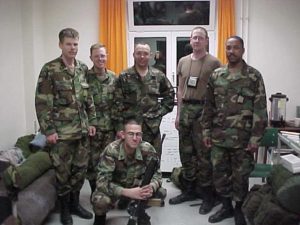
CPT Jose Aguilar (Center Standing), Commander, Bravo Company, 54th Engineer Battalion (1998-1999), Bamberg.
From the Engineer Advanced Course, he and his family were off to his first overseas assignment: Bamberg, Germany (1997-2000), where he began as a staff plans officer, followed up by a brief time as the acting operations officer (a Major’s position), before assuming command of Bravo Company of the 54th Engineer Battalion. While there, also serving, his wife, Captain Suzanne Aguilar, made the decision to leave service (1999) to become a full-time Mom for their growing family.
Three-years later and back in the States, Aguilar’s next assignment (2000-2002) was as an Observer-Controller at the Army’s National Training Center, at Fort Irwin, California. There he served as a Maintenance Trainer, then as the Engineer for the Airborne “Tarantula” Team, and finally, as a Company Trainer. The NTC provides the most realistic combat training through force-on-force (lasers) and live fire operations at the Brigade level. He and his fellow Observer-Controllers focused on teaching, coaching, and mentoring units while honing their own skills are practitioners of the profession of arms. During his time at NTC, Aguilar pinned on the rank of Major, and in 2002, he was selected to spend a year (2002-2003) studying at the Army’s Command and General Staff College, located at Fort Leavenworth, Kansas. “That school teaches you about brigade-level to Army-level operations. So, from a tactics perspective, now you’re honing your skills to be able to operate as a staff officer, or a leader, within the broader and bigger organizations in the Army,” said Aguilar.
Prior to CGSC course completion, he had interviewed for several next assignment locations, with his first choice being Fort Riley (KS), a comparatively convenient in-state family move from Fort Leavenworth. And he got his first choice! He and his family would be at Fort Riley from 2003 until about 2008. There, he served as the Group Maintenance Officer for the 937th Engineer Group. Then as the Group S-3, before moving to the 1st Engineer Battalion, also as the S-3, where he would go on to become its Executive Officer. What followed during the Fort Riley stationing, would be two deployments to Iraq, one with the 937th Engineer Group (2003-2004), and one with the 1st Engineer Battalion (2006-2007).
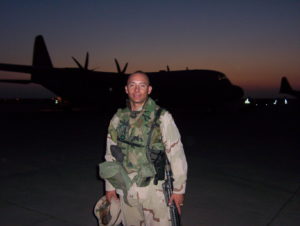
MAJ Jose Aguilar, Iraq, 2003.
He arrived for his first Iraq assignment in June 2003, “after the initial ground fight was complete. We stayed there to help train and stand up a new Iraqi Army. That was our mission,” remembered Aguilar. Some heavy fighting did, however, continue, with welcome invaluable combat help and force-strength supplied by the Third Infantry Division from Fort Stewart, Georgia.
His second Iraq deployment (2006-2007), with the 1st Engineer Battalion, was a focused combat route clearance mission in Multi-National Division North, and that was a 12-month tour, which turned into 15-months, prompted by the “Surge.”
As 1st Engineer Battalion Executive Officer, for Major Aguilar, the “Surge” deployment was definitely the tougher of the two, resulting in the loss of two of his soldiers. “Two is too many to lose,” he said, thinking back, “but with all of the (enemy) contact we had on nearly a daily basis, it was a miracle (that our deaths were limited to two), clearly assisted by the heavy training we did, and the great work that our junior leaders did there to protect their troops.” Aguilar remembers going out with his troops once every couple of weeks to do “leadership circulation” on the ground, while engaging in those patrols with them. “But really, the guys who saw some hairy stuff were my platoon-level leaders and below, because those guys were out there every single day, sometimes a couple of times a day, or if not, then on very long patrols, where they were under frequent enemy contact, and having to do whatever it took to keep those routes open for everyone else,” remembered Aguilar. And those routes simply had to be kept open, not only for the military, but in order to protect the surrounding local populace, as well, because “IED’s are indiscriminate,” he recalled, from direct observation.
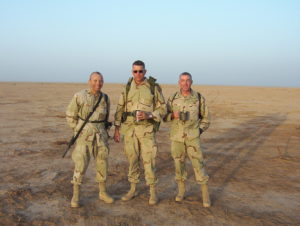
MAJ Jose Aguilar (left) with MG Eaton, in the middle of the desert, training the new Iraqi Army.
And some of his personal thoughts, reflecting back on those two Sergeants who had been lost. “There’s a certain amount of guilt within the leadership when you lose someone. The very first question you ask yourself, after you conduct your ‘battle drill,’ making sure the wounded are evacuated, and there’s no danger to others, is what did I not do right, that caused us to lose someone? I think that’s a natural thing we all go through. Pretty soon, you have to remind yourself to figure out how to grieve very quickly, and then move on, because there are six-hundred other soldiers that you’re responsible for, many of whom are right now actually out on patrol,” said Aguilar.
Fortunately, he never had to medically “evac” one of his own soldiers, but he did have to do so with a couple of local Iraqi civilians who got hurt near-by. The very next morning, just after losing one of their NCO’s, Aguilar went out on mounted patrol. Traveling with his team, they spotted a vehicle, sitting off to the side of the road, that just looked suspicious. It was similar to one that had exploded the previous day. The patrol “executed a battle drill,” where they began setting-up security on the far side of this four-lane divided highway. At that point, without any sound or warning, that parked red sedan just blew up. “It basically disappeared; the vehicle was no longer there,” remembered Aguilar. They immediately radioed up to their lead vehicles to be certain all personnel were OK. Other than one flat tire, all was well with his troops. Enemy insurgents appeared to be nowhere around, having apparently detonated the explosion remotely. But although our soldiers were fine, a couple of approaching locals soon were not.
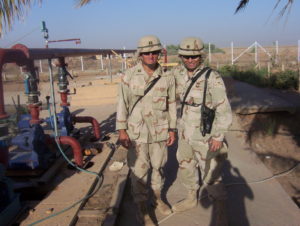
MAJ Jose Aguilar (right), near the Iranian Boarder, at an Iraqi Training Base.
The insurgents had positioned some mines where they thought Aguilar’s troops might be positioned in relation to that bomb-laden red sedan. Before long, a civilian tractor-trailer approached, with the driver instinctively moving to the side of the road to get out of the way of the vehicle explosion he’d just witnessed. In so doing, the truck hit a mine which blew off the entire right front axle. Riding in the cab of that truck, with the older male driver, was his nephew. Both were hurt from the mine blast, but not critically. Nonetheless, the patrol had to have both individuals evacuated for medical treatment. It all could have been worse for Aguilar’s men, but good fortune was riding with them on that patrol.
And about the enemy insurgents his soldiers were then facing in that sector of Iraq. Those enemy forces “were a combination of folks from the previous regime, along with some disillusioned others, with no way to make a living, so others would pay them to do those kinds of things (destructive acts). Not making excuses for that second group, because they, too, hurt us. And then there was also a combination of Iranian influences coming in there and assisting those disillusioned. That’s because Iran had everything to gain by getting involved and trying to prevent the new government (from succeeding) and, thus, preventing us from achieving peace in the area. It was all just a combination of folks. In some cases, it may have even just been kids who didn’t have anything better to do, so they were making a couple of dollars or making a name for themselves,” remembered Aguilar. Make a name or make a buck!
Looking back at his second Iraq deployment, Aguilar was asked what he most remembered about that experience. Said he: “I was just so impressed with our junior leaders. The reason is the discipline and the restraint they showed which was phenomenal, because there were some really bad people out there trying to hurt us.” As but one example of both discipline and restraint, Aguilar spoke of the times, when enemy individuals would be captured, and then our junior leaders had to travel to Baghdad to testify at their trials. He recalled that too many times, for a variety of reasons, those insurgents, known by our soldiers to be guilty of those crimes, were simply let go. What that meant was that not only was a patrol(s) back in the field going out short those two soldiers, but also that those same junior leaders had been sent away on a wasted trip. Our NCO’s were trained to treat their prisoners with respect, “as much as you can say that in warfare. Respect for their capabilities and respect for them as human beings,” said Aguilar. Laudable, especially, when you remember that the insurgent’s only goal was to kill or seriously wound American troops.
The second thing he remembered most about that time, centered more on his own job as an XO and the functions of the Battalion, “enabling those that are on the ground to have everything they need in order to be, and execute, ‘over-matched’ against the enemy.” In that regard, he recalled anxiously awaiting their shipment of Mine-Resistant Vehicles (rolled-steel, v-shaped deflecting bottoms) to arrive. And that was because “every day when our soldiers were out in those far safer vehicles, was a day I worried less. So, we were tracking their (vehicles) arrival and trying to get our units outfitted with the best optics, the best protection, the best jammers, with the best everything, to make sure that they had the very best chance out there facing danger,” said Aguilar. “From the battalion all the way up to the national level, and the American people, the efforts we went through to ensure that our soldiers had the upper-hand in combat was phenomenal. From the investments we made in those superior protective vehicles, to the medical attention that was given all the way back to hospitals in the States, and how folks survived who would not have even ten-years earlier. In my view, that backing, and effort, was all just terrific.”
In January of 2008, Major Aguilar & family headed to Portland, (OR), as the Deputy District Commander and Deputy District Engineer for the Portland District, United States Army Corps of Engineers. When he was still in Iraq, and beginning to think about his next assignment, he remembered that his Branch Officer (assignments) had called him, saying: “I’ve got a couple of options for you. You can either come back home, high-five your wife, and go back to Iraq, or you can go to Korea, or you can go be on an observer-controller team that trains and travels all the time (based out of Fort Leavenworth).”
Still in Iraq and on his second and long (15 month) deployment, Aguilar remembers his response was as follows: “Listen, I probably don’t need to tell my wife what options you just gave me, so let me see what I can find and I’ll get back with you!” Given those less-than-attractive options, both for him, and especially for his family, this became the first time in his career that he realized he could actually have at least some say in where he wanted to go next. His wife, Suzanne simply asked him to be with the family for at least a year. The branch assigners are always up to their elbows in work, trying to fill open positions, or as Aguilar put it, “putting butts in seats.” Further, he said: “I respect what they do and would never want that job, but I had been away too long.” He felt he could actually try to help the process along by hopefully finding a compatible open slot by himself. And, in this case, it worked! He did some serious looking around, primarily by contacting a number of Army friends for any job leads they might have. Then, at some point, Suzanne, suggested she’d never been to the Pacific Northwest, so perhaps he could find something in that region? For that possibility, Aguilar then turned his search to the Corp of Engineers for any potential openings they might have in their Northwest region. As (well deserved) good fortune smiled down upon him once again, he located a soon-to-be-open CoE Deputy Commander and Deputy District Engineer position. He interviewed for it, got it, and the Aguilars were then happily on their way to, not Iraq, not South Korea, but Portland, Oregon!
Now, before moving into a discussion of his military-civilian Corps of Engineers experience, and after his having successfully completed two Iraq engineer deployments, from his unique experiential perspective, Major Aguilar was asked to go back several years in time and focus specifically on, and fully explain, the role of combat engineers within the total Army engineer compliment.
Combat engineers, he said, provide mobility, counter-mobility, and survivability support for the warfighters. Aguilar described the specifics of those combat requirements as follows: “For mobility, if there’s an obstacle, you end up bypassing or breaching it to allow the forces to continue forward. If there’s a trail that needs to be cut in order to allow forces to move ahead to the desired destination, they would make that trail with the appropriate equipment. With counter-mobility, if you’re on the defense, then you create obstacles to prevent the enemy from just attacking and reaching you faster, with nothing in their way. Those imposed obstacles, then, are to allow the maneuver forces to have more time to engage the enemy and destroy them or prevent them from going to an area where you may have weaknesses. Lastly, survivability would be things like digging a fighting position for our tanks, so that they would only come up into partial view when they engage the enemy. Or, also, to protect our soldiers, by digging positions for them,” he said.
Along with the combat engineer, there are also Army construction engineers, whose functions include building infrastructure, roads, and airfields, among other essential projects to assist our fighting forces. In some cases, secondarily to the needs of the fight, they may also work to fulfill some construction project needs that would help the local populace, as well. On this subject, it’s interesting to note that while Captains Aguilar were both stationed at Fort Carson, Jose Aguilar was a combat engineer, while Suzanne Aguilar served on the construction engineer side. Both specialties are critical to the success of our fighting force missions. Besides combat and construction designations, additional Army engineer functions include diving, firefighting, map making, and terrain analysis (pre-patrol advice to soldiers on specific ground formations and elevations they will encounter).
But now, out there, in the fight itself, what is the riskiest thing that combat engineers might have to face? “In my view,” said Aguilar, “that would be the task of breaching. Doctrinally, it’s a combined arms effort. You’re up there with armor and infantry forces, lead elements, and you’re having to move forward, under fire, to find and bypass or breach whatever the obstacle is (identify via prior reconnaissance, or worst case, just bumping into it!), in order to allow our force to then penetrate through it, and assault to destroy the enemy. What that means is, you’re already in an area that is dangerous, like, a mine field, for instance, plus you’re out there in front, and quite probably being fired upon. Now, if you have some pretty good maneuver guys, they’re protecting you, and destroying them or at least making the enemy troops keep their heads down. But, regardless, indirect fire is, likely, still coming in on you. So, from my experience, breaching is the most dangerous thing our combat engineers have to do,” he said.
Once the obstacle is cleared, the engineers then create the initial penetration and mark a lane to the far side, then secure it, making way for the assault force, which then “punches” through, while our support force continues to keep the enemy occupied, as the assaulters close with and destroy the enemy, clearing the far side of the objective. Then everyone on the remaining team moves through, consolidating and reorganizing on the mission objective. The next concern: Preparing while waiting for the anticipated counterattack, as the enemy attempts to take back that position. At which point the engineers may now be in the role of counter-mobility.
“However, if you notice what happened in Iraq and Afghanistan,” said Aguilar, “engineer units were, for the most part, functioning on their own to execute missions, out front, where, in that instance, they searched for IED’s and cleared them. The reason we were able to do that was because the enemy was not one that could overwhelm and overpower an engineer platoon. Our engineer platoons could hold their own, with the firepower we had, utilizing the combined arms team. Very often, the first element of that combined team focus was aviation, used to bring fires down on the enemy from above. And then, another maneuver force, like an infantry or armor company, that is, if the enemy’s force was big enough, would be called in to make contact with, and destroy, the enemy, while the engineers, then, completed their mission. That’s why, in both Iraq and Afghanistan, when necessary, you saw Army engineers functioning on their own because, number one, the enemy wasn’t big enough to provide a threat to annihilate an engineer platoon, and number two, there wasn’t enough coalition combat power to go around.”
Aguilar explained further: “Enemy forces in Iraq and Afghanistan could not afford to be that large because, if they left a big enough ‘footprint,’ we could more easily find them, fix them, and destroy them, either by indirect fire, Air Force fires, or with one of our ground units. What they chose to do, instead, was to function more in small teams, or even as individuals, and so most of the time, we didn’t really need someone protecting our engineers, since they usually had enough combat power to find and destroy the enemy on their own. We always wanted ‘over-match.’ We never want to put any of our military members out there in a position where, unexpectedly, it becomes our own guys who end up over-matched! Now, if there are warnings and indicators of some large element that could threaten one of ours, then we employ additional ground elements or fires. And, yes, that did happen! In which case we needed to employ the air or ground fires that could effectively attrite the enemy threat, prior to them making contact with our forces, and then our forces can either handle the situation, or at least hold that position until reinforcements arrive,” he said.
How did combat engineers actually locate mines and IED’s? Replied Aguilar: “First, it’s important to understand that our concern was not with the entire country of Iraq! We focused on things like lines of communication, and roads, within our specific area of responsibility. The key to informed route (road) clearance is ‘change and detection.’ We were using mounted patrols, traversing that terrain all the time, so that our soldiers (aided by optics) were able to observe things like a curve in the road that now doesn’t look like it looked yesterday. Or the people in the little villages are not acting the way they were before. Or that car was not there on our last patrol; what is it doing there? Detecting change. That’s the responsibility of those there on the ground to figure out. For instance, using that first example: Is that a new, but fake, curve in the road built to contain an IED? Does the dirt look fresh, disturbed, or discolored? It was our lead guys who were spotting those kinds of things, different objects, different surroundings, any changes. Their observations where then confirmed by using the very latest equipment, such as optical aids, robots, and the other technology that makes our Army of today so lethal,” said Aguilar.
Regarding the critical need for mine and IED detection, Aguilar continued: “The second detection factor (after, observed ‘change’) is that back at the Command Post, there’s information that’s being gathered from all kinds of sources, that tells you what kinds of tactics, techniques, and procedures certain enemy elements are using, so that, you can try to predict (predictive analysis/historic trends) where hazards may exist or enemy lethal tactics may be migrating across the battlefield.”
To give you an idea of the success, it was just a few months after we were in theatre that our intelligence ‘shop’ in the battalion was able to gather information from all echelons, and then tell our patrol before departing, for example, that sometime between the hours of x and y, you will have an individual placing an IED here, and it’ll be this kind of IED (!). So, now you’re in the enemy’s cycle, and what you’re then able to do is drop off a team that’s going to observe that intersection, or that area, and when the enemy individual(s) arrive, we report back, and since we already have a team in place, we can take appropriate action. That collective intelligence allowed us to literally get in front of the enemy’s decision cycle, and now we’re on the offense, rather than having to play defense. There’s an Army saying: Intelligence drives operations; operations drives logistics and it’s a cycle, not linear. And, yes, offense is better than defense!” said Aguilar.
Summarizing his detailed description of combat engineers and their functions: “Even when you’re out going into the middle of nowhere, you would have combat engineers along in case you find an obstacle or explosive, so they could go ahead and clear it, in order to allow the force to continue to their objective.”
Back now to Major Aguilar’s new Deputy District Engineer experience in Portland, Oregon. He was asked why pursue and gain the position in Portland, other than the fact that it was, at that time, preferable for both he and his family, rather than, say, going to South Korea or spending yet more time in Iraq? “Because I knew that, as an engineer, I needed to understand how things were done at the national level in order to progress in my career. During my first time in Iraq, I was impressed by a Colonel who joined our group, and who had previously been with the Corps of Engineers. When we had to develop the program for the new Iraqi Army, and then explain the funding needed for facilities, equipment, etc., he (Colonel) was able to put the project request into ‘Congressional language;’ its scope, justification, and estimate of total costs, for eventual submission to the Administration and then, Congress, in order to obtain that needed funding. You need both the authority, and then the monies, to be able to do the assigned mission (in this case, the enormous task of standing up a new Iraqi Army). I was impressed with his ability to communicate so effectively at the national (civilian) level,” recalled Aguilar.
What, then, was his primary career value take-away, from his time there with the Corps in Portland? “Frankly, the value to me was, I think, much larger than the value I provided to the organization. Because when I left, I’d learned so much, and I felt like I really hadn’t contributed a lot. They spent a great deal of time getting me up to speed to understand how the Corps of Engineers operates. Also getting me to thoroughly understand, perhaps for the first time, that ‘everything costs’! For instance, if we had a meeting with, say ten people, at a time & a salary rate of so-much per person attending, I now had to think, was that meeting really worth the collective cost? And, if not, why? And what could we do to change that? Because the Corps of Engineers runs itself like a business. Everything costs. So, whatever actions you take, will have an impact on expenses,” said Aguilar. By the way, it was really refreshing to hear that the CoE does its very best to operate like the private sector, where entities must live by the bottom line, and where there is no Treasury printing press for back-up and bail-out! Government (federal/state/local) organizations don’t always seem to operate within that reality. Understatement, perhaps?

LTC Jose Aguilar, wife Suzanne, and family at his promotion ceremony in Portland, Oregon with the Corps of Engineers, 2009.
And, then, after ‘everything costs,” what was the second thing of value that Aguilar learned during his time in Portland? “I learned how to work with the civilian work force,” he said. It’s not that they’re any less motivated than the military, they’re just motivated in a different way. They’re just as dedicated, they’re just as committed to the mission. But with the military, if required in a crisis, you can work your troops 24/7. Not so, of course, with civilians. You need to give them very specific guidance (vs. ‘orders’!), and you need to be sure you pay them for any overtime, along with assorted other civilian workforce policies. For instance, with the military, you can give soldiers a paid day off. With civilians, you can’t just give them a day off with pay! That’s not the way the system works. So, it took me a little bit to figure out that the rules were quite different!”
“Finally,” said Aguilar, “it (time in Portland) gave me a view into the broader perspective of how things are done in our government(s). As a part of my responsibilities, I was helping my commander brief Congressional delegations, as well as meeting with state and local (city/county) governments (about things needing to be done in their respective areas). We were meeting with Native American tribal members (Pacific Northwest tribes), who had treaties with the U.S., and we were trying to work through opportunities and challenges within those commitments. We met with environmental groups. Then there was evaluating proposals submitted by contractors to determine the best value for the government. All of this, again, allowed me to see the broader federal/state/local perspective. And then, internal to the District, it showed me that you also have to be continually concerned about public affairs. To be certain that everything is well coordinated among the District’s lawyers, engineers, etc., and so that we can be publicly, as well as administratively, successful with the missions assigned to us by the Congress and the Administration,” said Aguilar, concluding his key recollections from his first, of ultimately two, assignments with the Portland District.
Then, in 2009, now-Lieutenant-Colonel Aguilar moved into Battalion-level command, as he began his two-year tenure (2009-2011) as the Garrison Commander at Hunter Army Airfield in Savannah, Georgia. “The really cool thing about that assignment,” LTC Aguilar recalled,” was that I had just come from an assignment where I understood the broader perspective of working with civilians, along with making some decisions that have political implications, so that previous job (Corps of Engineers) really helped me to step into the Garrison Command, now more fully understanding that civilian employees make huge contributions to America’s Army,” said Aguilar.
Moving, now, into his thoughts about his Hunter (HAAF) Command experience: “The most rewarding thing about that assignment was the people. And the toughest thing about it was…the people!” (a knowing chuckle from the LTC!). Rewarding: “There were so many just phenomenal folks, inside and outside of the gate, that helped me get the mission done there as the commander. Great, great people. As but one example, and an important one, Glenda Johnson (veteran garrison command executive administrative assistant) “who took me under her wing, being probably her 20th Garrison Commander, and she didn’t use that as a power base to get something, but used it as an educational piece for me, to make sure that I started off running and making contributions, helping our community, both inside and outside of the gate. So, people were the favorite and the best thing about that assignment,” remembered Aguilar.
But then, there were some challenges during his Hunter tenure. As he had stated above, some people were not, as it turned out, a good and proper fit. “Within any organization, there are bound to be a couple of bad apples,” he said. “And unfortunately, toward the end of my command, I had no choice but to relieve two senior leaders. Now, we all have faults, as do I. Their huge fault, that led directly to their downfall, was that they believed that rank has its privileges, but without responsibility, or any accountability, to others. Therefore, they committed some offenses and because they were in positions of power, felt they could, continually, get away with it. They had to have known it was wrong. But they just felt like they were above the ‘law,’ because they were senior. Both of those cases were very, very difficult for me, to take the action(s) necessary to ensure that each one was no longer a part of the team,” recalled Aguilar.
Where there any further thoughts that LTC Aguilar wanted to share about his Garrison Commander time at Hunter? “I just can’t say enough about how supportive that community was,” he said, thinking back. “I was amazed. As an example, there was one Christmas when all of our kids had one, maybe two, presents from the local community. They brought in trailer-loads of presents. Bikes, you name it! Then another example that comes to mind was when Chatham Steel Corporation in Savannah (CEO Bert Tennenbaum) came in and donated time and money to make the Halloween House (on-post) just so much fun for our kids. I could give you examples of that across-the board. Another one, WTOC-TV, the types of thing that organization did to help with getting our message out when something was happening (on-post), so that we could make sure that our side, too, was being communicated. So, from the Chamber, from the Rotary Club, from other local entities, everybody was just incredibly supportive,” said Aguilar.
As a personal side note, and not a given for all military stationing locations, the residents of Savannah and surrounding communities have a very long history of exceptional pro-military commitment, with strong support, specifically, for the installations and units we’re blessed to have within our region. The community, and many of its organizations, appreciated the openness, and the sincere desire to become involved outside the gate, demonstrated continually by LTC Aguilar. Those efforts, that friendliness, were reciprocated in kind by Savannah and the surrounding area. Needless to say, he made, and left, a very positive impression for the Army, for Hunter, and or himself, during his time here with us.
So, then, as he prepared to finish out his two-year command tour at Hunter Army Airfield, in 2011, LTC Aguilar interviewed for the position, and was selected to become the next Chief of Staff to the Commandant of the United States Engineer School at Fort Leonard Wood, Missouri. Following his time in command, working with a large number of military civilian employees, and after his previous west coast experience with the largely civilian workforce at the Corps of Engineers, Aguilar saw the Engineer School assignment as the chance “to go and ‘re-green’ myself to what Army engineers were doing, what equipment we’re bringing in, how we’re training soldiers, etc. As the Chief of Staff, the Basic (engineer) Course, the Advanced Course, the Sapper Leader Course, and the Museum, all those things fell under the Commandant’s Office, which enabled me to play a role in influencing some of those activities, which was pretty neat, actually, since I’d gone through all of that training,” he said. Although he would have preferred to remain in that position for the normal two years, LTC Aguilar was competitively selected to attend the Army War College, and so, of necessity, his staff tour at Fort Leonard Wood was cut short, but for the very best of reasons, the prestigious appointment to the Army’s senior officer school!
From 2012-2013, the LTC (and family) was in residence at the War College in Carlisle, Pennsylvania. “There, you’re directed to read, and that becomes your primarily focus, and to further develop yourself, kind of like at West Point. They put everything in front of you to better yourself, to think at a higher level. You are assigned to read some of the military classics, to go back and look at some things that were done, look at some after-action reviews for certain events and missions, and then pull one’s thoughts together and write! My ‘capstone’ thesis paper was about the positive and negative impacts of water on security, here and across the world. Some of those impacts we’re actually seeing take place now. What that experience (War College) actually did for me was to allow me to have a little bit more time with my family. Also, importantly, it allowed me the time to think, allowed me to read, and that enabled me to then think more deeply about my profession, and how it relates to the nation and the world, hopefully a secure and prosperous one,” said Aguilar.
His time, study, and reflection in Carlisle resulted in his earning a Masters’ Degree of Strategic Studies. Former Fort Stewart/HAAF Commanding General, MG Tony Cucolo, was the Army War College Commandant during Aguilar’s time there. Coincidentally, he was also the CG during LTC Aguilar’s time in command at Hunter AAF Garrison! Now retired from the Army, General Cucolo was back then, and still is today, an outstanding, dedicated, smart, and incredibly articulate leader.
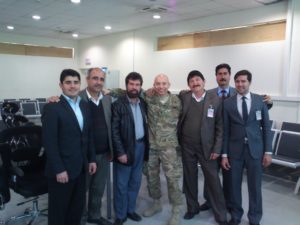
LTC Jose Aguilar, (center), with representatives of Defense and Finance Ministries of Afghanistan.
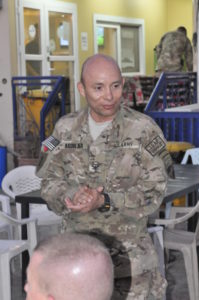
LTC Jose Aguilar talking with our NATO team in Afghanistan.
Upon completing his Army War College assignment, which included his promotion to full Colonel (which MG Cucolo officiated), Aguilar felt the need to stabilize the family, since his daughter, Allison, would be entering her senior year and a move at that point would have put her in four different schools in four years(!). So, he applied for, and received, a one-year teaching position right there in Carlisle at the War College. Or so he thought! Seems the Army had another plan for its new Colonel. While his family would, in fact, be staying that next year in Carlisle, Colonel Aguilar would not. As the needs of the Army prevailed, he would be spending that next year (2013-2014) deployed to Afghanistan as the Chief of Basing, for then-Lieutenant-General Milley, Commander of the ISAF Joint-Command. At that time, we were reducing the number of bases there, as we began reducing, as well, American force strength. “My role, then, was to orchestrate the draw-down of bases, coordinating those decisions with the Afghan Government and with our allied nations, including, of course, the U.S.”
At just about the time he was preparing to leave Afghanistan, he was selected to return to the Corp of Engineers in Portland, this time as District Commander (2014-2017). “That job was phenomenal because of all the things we were doing to conduct the civil works mission throughout Oregon, SW Washington, and a sliver of Northern California. The primary missions were to run the dams (Bonneville, etc.) on the Columbia River to enable the transportation of goods, and also to produce hydro-power for the Pacific Northwest. A collateral mission, then, was dredging those rivers and harbors to help ensure the flow of commerce. Then, on the Willamette River, there was also some hydro-power production, while providing for recreation, as well as the environmental restoration of fisheries, and those type of things. And as before, interacting with tribes, Congressional members, and with local and state governments. It was just a great, great job,” recalled Aguilar.
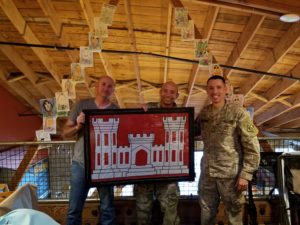
COL Jose Aguilar, (center), presented the Portland District Colors by his team.
Regarding his on-going need to meet and negotiate with regional Native American tribal representatives, the key from the Corps’ standpoint was maintaining ‘responsible development.’ “As we develop certain areas for industry or for commerce, our goal was to ensure that it was not having a negative impact on the environment. Development vs. environment. Protection of the environment. So, with the tribes, as well as other concerned groups, what we had to do was demonstrate that there would be no adverse impact, or if there might be potential for such, what we were doing to effectively mitigate it, to every extent possible” he said.
His next tour, then, would become the final active-duty assignment in Colonel Aguilar’s almost three-decade U.S. Army career. From 2017-2020, he would serve as the Deputy Director of Logistics and Engineering, and the Command Engineer, Headquarters, North American Aerospace Defense Command (NORAD) and United States Northern Command (USNORTHCOM), at Peterson Air Force Base in Colorado Springs, Colorado.
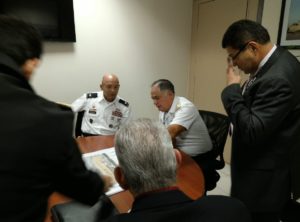
COL Jose Aguilar in discussions with Admiral Padilla of Mexico’s SEMAR (Navy) in order to develop capabilities through Theater Security Cooperation.
NORTHCOM is one of only six American geographic combatant commands globally, meaning that Aguilar had been selected for a position of broader responsibility, at a higher level of service, than he had ever before experienced. While NORAD is a bi-national command, which answers to Canada’s Prime Minister and the President of the United States, and is focused on the Defense of North America. For both of the commands, said Aguilar: “It’s about defending our homelands. Defending the U.S. and Canada. And then, also, coordinating with Mexico and the Bahamas for the defense of our southern borders and the Caribbean. Understanding that those threats are out there, and that we need to continue to be vigilant, realizing along with that, the need to develop technologies and weapons systems to counter our enemies, so that we can protect our way of life.”
Another aspect of his operational reality and responsibility at this level is “the complexity of how our nations make defense investments, and how we need to have open discussions with our partners to be certain that they are investing in the right areas, to ensure the security and prosperity of our respective nations,” said Aguilar.
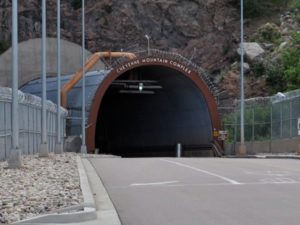
NORAD’s Cheyenne Mountain Complex.
Then there are the actions taken through NORTHCOM for the U.S. Department of Defense support of civil authorities: “Things like response to hurricanes and wildfires, as well as any other kind of natural and man-made disasters, always in support of a civilian lead federal agency (for instance, FEMA). It’s very sobering to see that we get involved with all of that (aside from the nation’s defense), when the other agencies of our federal government don’t have the necessary resources in some cases to address every situation that might arise. It’s at that point that they will reach out to DoD to come in and assist,” he said. Aguilar spoke also of the work that NORTHCOM does with our partner countries in the area of security operations, to be certain that all is in the best interest of our collective nations and needs.
And, finally, on a personal note, he said: “It’s just pretty neat to see that, from a stationing perspective, we’ve now come full circle, having started our Army career here in Colorado Springs (Fort Carson), and now finishing here as well. It’s also special because our two daughters were born here (their son was born during their deployment to Germany). Suzanne and I started here with no kids at home and we end here with no kids at home!”
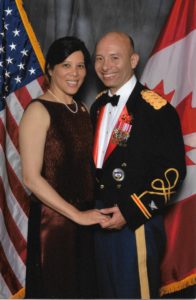
COL Jose Aguilar and his wife Suzanne at the Portland District Birthday Ball.
The Colonel was then asked, through all of these years, what the Army has meant to him. “The Army’s been my life! You could make the argument that I really don’t exist outside of the Army. Although with retirement coming up, I have to! So, let me start with what the Army has given me. It’s given me an education (West Point). And you could also argue that it ‘issued’ my wife to me, because that’s how I met her (also a WP engineer graduate). They allowed us to have and care for our kids (available medical care), to help bring them up (great programs for children), and to raise them in a safe environment. Whenever I’d show up at a new unit, they’d issue me absolutely everything that I’d need, including, in some cases, a vehicle and a driver. How cool is that! So, the Army’s been the world to me. It’s been awesome. It’s been a great way to serve my country. And it’s been a great way to provide for my family. So, yes, the Army is my life,” said Aguilar, from the heart, as he concluded his remarks.
Colonel Jose Aguilar will formally retire from the United States Army at the end of Year 2020. He and his wife, Suzanne, plan to retire to the State of Texas to be closer to extended family. Their three children are all grown and living on their own in three different geographic locations. The Aguilar’s have two grandchildren, to-date. Son Joey recently graduated from a university ROTC program and received his officer’s commission in the U.S. Army Reserve as, like his Dad, an Engineer. Their daughters have both become nurses. So the Aguilar Family’s Army connection, and dedication to service, continues.
UPDATE (6/24): Colonel Jose Aguilar now lives at The Woodlands (north of Houston, Texas). Applying his extensive engineering background, Jose works for STV Company, a national architectural & engineering firm, where he is Vice President and Manager for the Greater Houston Area.


